Academic & Business Research Report: Unit 3 and 8 Learning Log Tasks
VerifiedAdded on 2020/03/16
|10
|2230
|110
Report
AI Summary
This report presents an analysis of academic and business research, focusing on stakeholder theory, corporate social responsibility (CSR), and sustainable supply chain management. It begins with an examination of key articles related to stakeholder theory, ranking them based on their impact and publication metrics. The report then delves into the application of stakeholder theory, exploring how organizations balance profit maximization with environmental sustainability. It includes an analysis of a case study, investigating the decision-making processes within firms striving to achieve both economic and environmental goals. The study uses a grounded theory approach, analyzing secondary data from trade magazines, newspapers, and environmental firm membership lists to understand how organizations address the challenges of sustainable supply chain management. The report also contains an analysis of statistical significance in a business context. Finally, it discusses the findings related to firms' environmental postures and how they influence supply chain decisions. The report concludes by highlighting the importance of balancing priorities in sustainable supply chain management and provides recommendations for businesses seeking to restructure their operations.
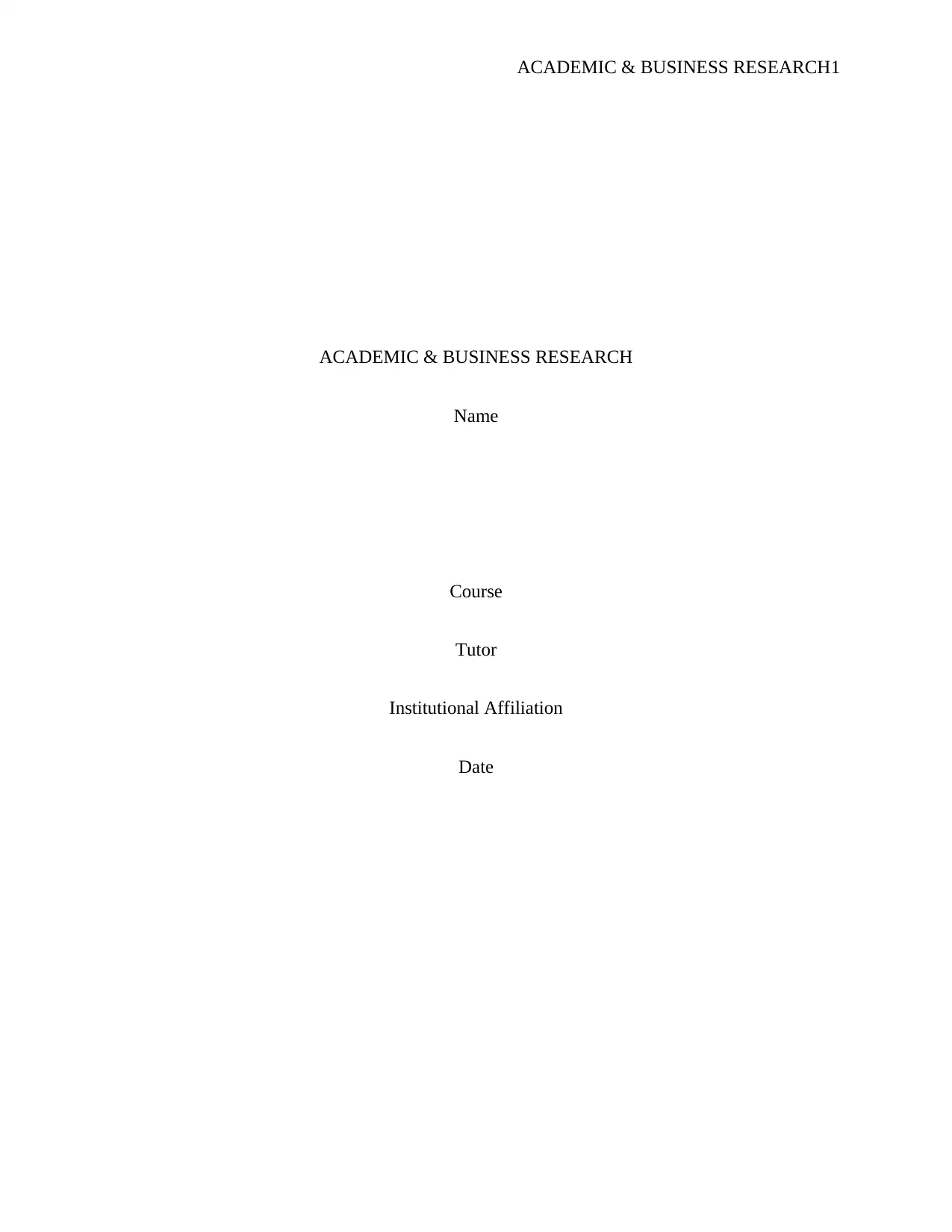
ACADEMIC & BUSINESS RESEARCH1
ACADEMIC & BUSINESS RESEARCH
Name
Course
Tutor
Institutional Affiliation
Date
ACADEMIC & BUSINESS RESEARCH
Name
Course
Tutor
Institutional Affiliation
Date
Paraphrase This Document
Need a fresh take? Get an instant paraphrase of this document with our AI Paraphraser
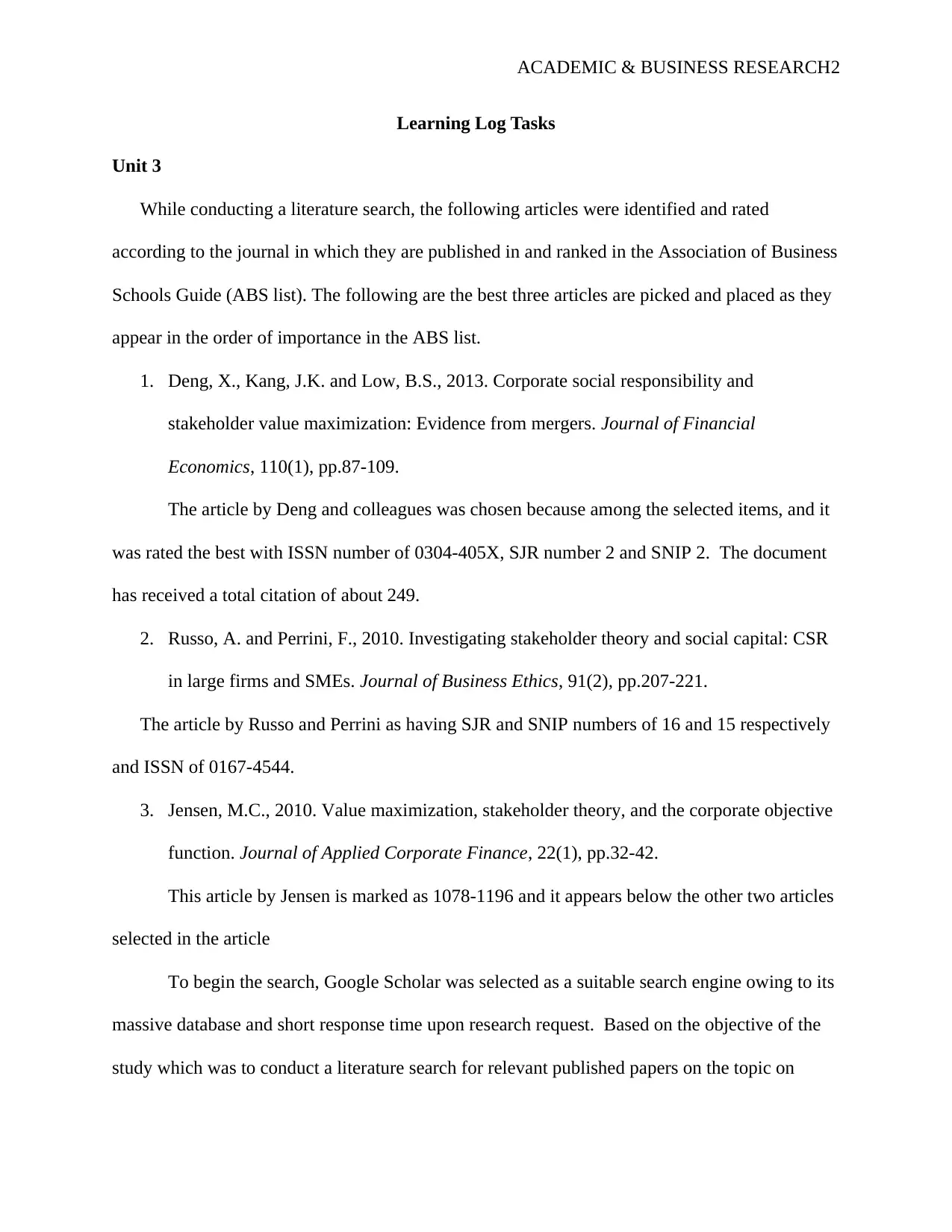
ACADEMIC & BUSINESS RESEARCH2
Learning Log Tasks
Unit 3
While conducting a literature search, the following articles were identified and rated
according to the journal in which they are published in and ranked in the Association of Business
Schools Guide (ABS list). The following are the best three articles are picked and placed as they
appear in the order of importance in the ABS list.
1. Deng, X., Kang, J.K. and Low, B.S., 2013. Corporate social responsibility and
stakeholder value maximization: Evidence from mergers. Journal of Financial
Economics, 110(1), pp.87-109.
The article by Deng and colleagues was chosen because among the selected items, and it
was rated the best with ISSN number of 0304-405X, SJR number 2 and SNIP 2. The document
has received a total citation of about 249.
2. Russo, A. and Perrini, F., 2010. Investigating stakeholder theory and social capital: CSR
in large firms and SMEs. Journal of Business Ethics, 91(2), pp.207-221.
The article by Russo and Perrini as having SJR and SNIP numbers of 16 and 15 respectively
and ISSN of 0167-4544.
3. Jensen, M.C., 2010. Value maximization, stakeholder theory, and the corporate objective
function. Journal of Applied Corporate Finance, 22(1), pp.32-42.
This article by Jensen is marked as 1078-1196 and it appears below the other two articles
selected in the article
To begin the search, Google Scholar was selected as a suitable search engine owing to its
massive database and short response time upon research request. Based on the objective of the
study which was to conduct a literature search for relevant published papers on the topic on
Learning Log Tasks
Unit 3
While conducting a literature search, the following articles were identified and rated
according to the journal in which they are published in and ranked in the Association of Business
Schools Guide (ABS list). The following are the best three articles are picked and placed as they
appear in the order of importance in the ABS list.
1. Deng, X., Kang, J.K. and Low, B.S., 2013. Corporate social responsibility and
stakeholder value maximization: Evidence from mergers. Journal of Financial
Economics, 110(1), pp.87-109.
The article by Deng and colleagues was chosen because among the selected items, and it
was rated the best with ISSN number of 0304-405X, SJR number 2 and SNIP 2. The document
has received a total citation of about 249.
2. Russo, A. and Perrini, F., 2010. Investigating stakeholder theory and social capital: CSR
in large firms and SMEs. Journal of Business Ethics, 91(2), pp.207-221.
The article by Russo and Perrini as having SJR and SNIP numbers of 16 and 15 respectively
and ISSN of 0167-4544.
3. Jensen, M.C., 2010. Value maximization, stakeholder theory, and the corporate objective
function. Journal of Applied Corporate Finance, 22(1), pp.32-42.
This article by Jensen is marked as 1078-1196 and it appears below the other two articles
selected in the article
To begin the search, Google Scholar was selected as a suitable search engine owing to its
massive database and short response time upon research request. Based on the objective of the
study which was to conduct a literature search for relevant published papers on the topic on
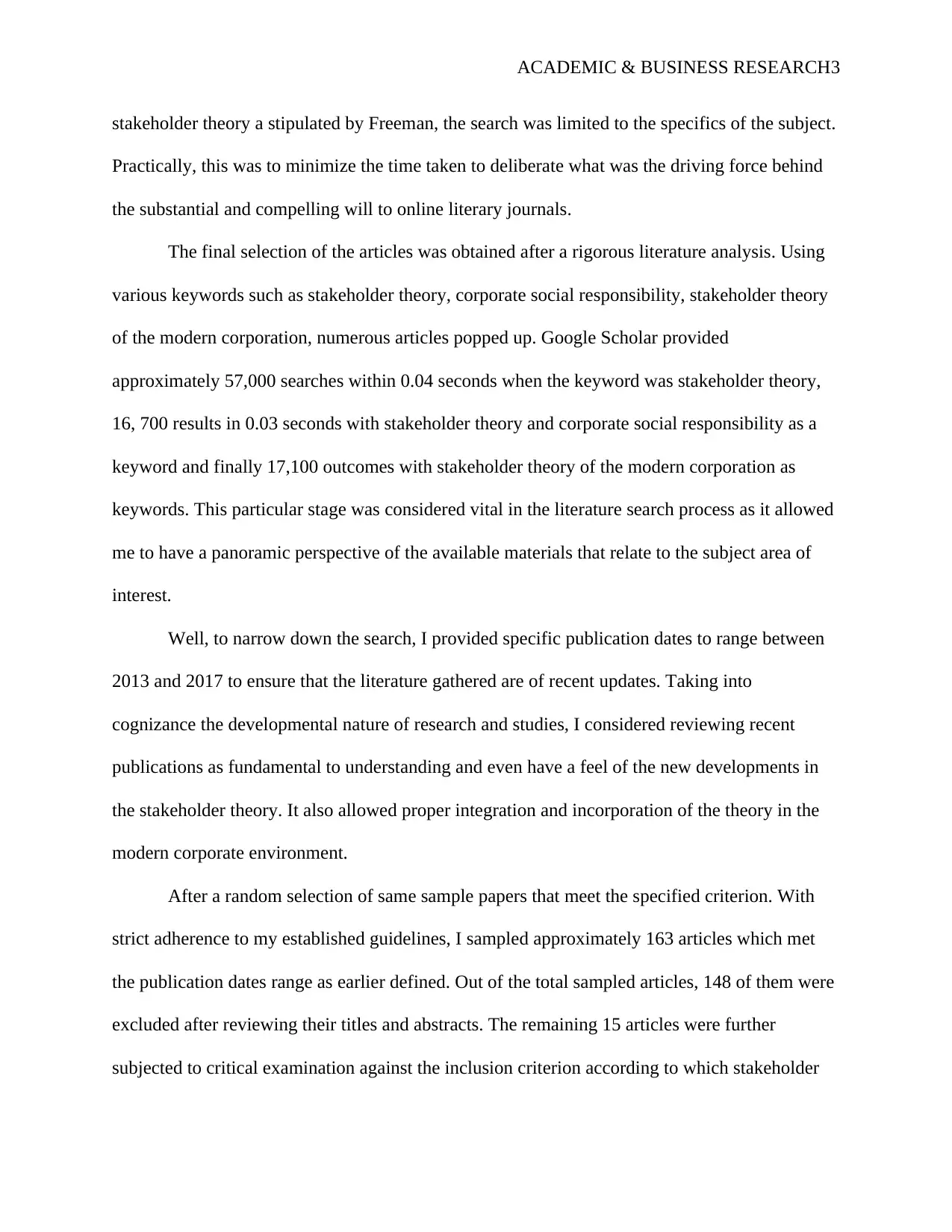
ACADEMIC & BUSINESS RESEARCH3
stakeholder theory a stipulated by Freeman, the search was limited to the specifics of the subject.
Practically, this was to minimize the time taken to deliberate what was the driving force behind
the substantial and compelling will to online literary journals.
The final selection of the articles was obtained after a rigorous literature analysis. Using
various keywords such as stakeholder theory, corporate social responsibility, stakeholder theory
of the modern corporation, numerous articles popped up. Google Scholar provided
approximately 57,000 searches within 0.04 seconds when the keyword was stakeholder theory,
16, 700 results in 0.03 seconds with stakeholder theory and corporate social responsibility as a
keyword and finally 17,100 outcomes with stakeholder theory of the modern corporation as
keywords. This particular stage was considered vital in the literature search process as it allowed
me to have a panoramic perspective of the available materials that relate to the subject area of
interest.
Well, to narrow down the search, I provided specific publication dates to range between
2013 and 2017 to ensure that the literature gathered are of recent updates. Taking into
cognizance the developmental nature of research and studies, I considered reviewing recent
publications as fundamental to understanding and even have a feel of the new developments in
the stakeholder theory. It also allowed proper integration and incorporation of the theory in the
modern corporate environment.
After a random selection of same sample papers that meet the specified criterion. With
strict adherence to my established guidelines, I sampled approximately 163 articles which met
the publication dates range as earlier defined. Out of the total sampled articles, 148 of them were
excluded after reviewing their titles and abstracts. The remaining 15 articles were further
subjected to critical examination against the inclusion criterion according to which stakeholder
stakeholder theory a stipulated by Freeman, the search was limited to the specifics of the subject.
Practically, this was to minimize the time taken to deliberate what was the driving force behind
the substantial and compelling will to online literary journals.
The final selection of the articles was obtained after a rigorous literature analysis. Using
various keywords such as stakeholder theory, corporate social responsibility, stakeholder theory
of the modern corporation, numerous articles popped up. Google Scholar provided
approximately 57,000 searches within 0.04 seconds when the keyword was stakeholder theory,
16, 700 results in 0.03 seconds with stakeholder theory and corporate social responsibility as a
keyword and finally 17,100 outcomes with stakeholder theory of the modern corporation as
keywords. This particular stage was considered vital in the literature search process as it allowed
me to have a panoramic perspective of the available materials that relate to the subject area of
interest.
Well, to narrow down the search, I provided specific publication dates to range between
2013 and 2017 to ensure that the literature gathered are of recent updates. Taking into
cognizance the developmental nature of research and studies, I considered reviewing recent
publications as fundamental to understanding and even have a feel of the new developments in
the stakeholder theory. It also allowed proper integration and incorporation of the theory in the
modern corporate environment.
After a random selection of same sample papers that meet the specified criterion. With
strict adherence to my established guidelines, I sampled approximately 163 articles which met
the publication dates range as earlier defined. Out of the total sampled articles, 148 of them were
excluded after reviewing their titles and abstracts. The remaining 15 articles were further
subjected to critical examination against the inclusion criterion according to which stakeholder
⊘ This is a preview!⊘
Do you want full access?
Subscribe today to unlock all pages.

Trusted by 1+ million students worldwide
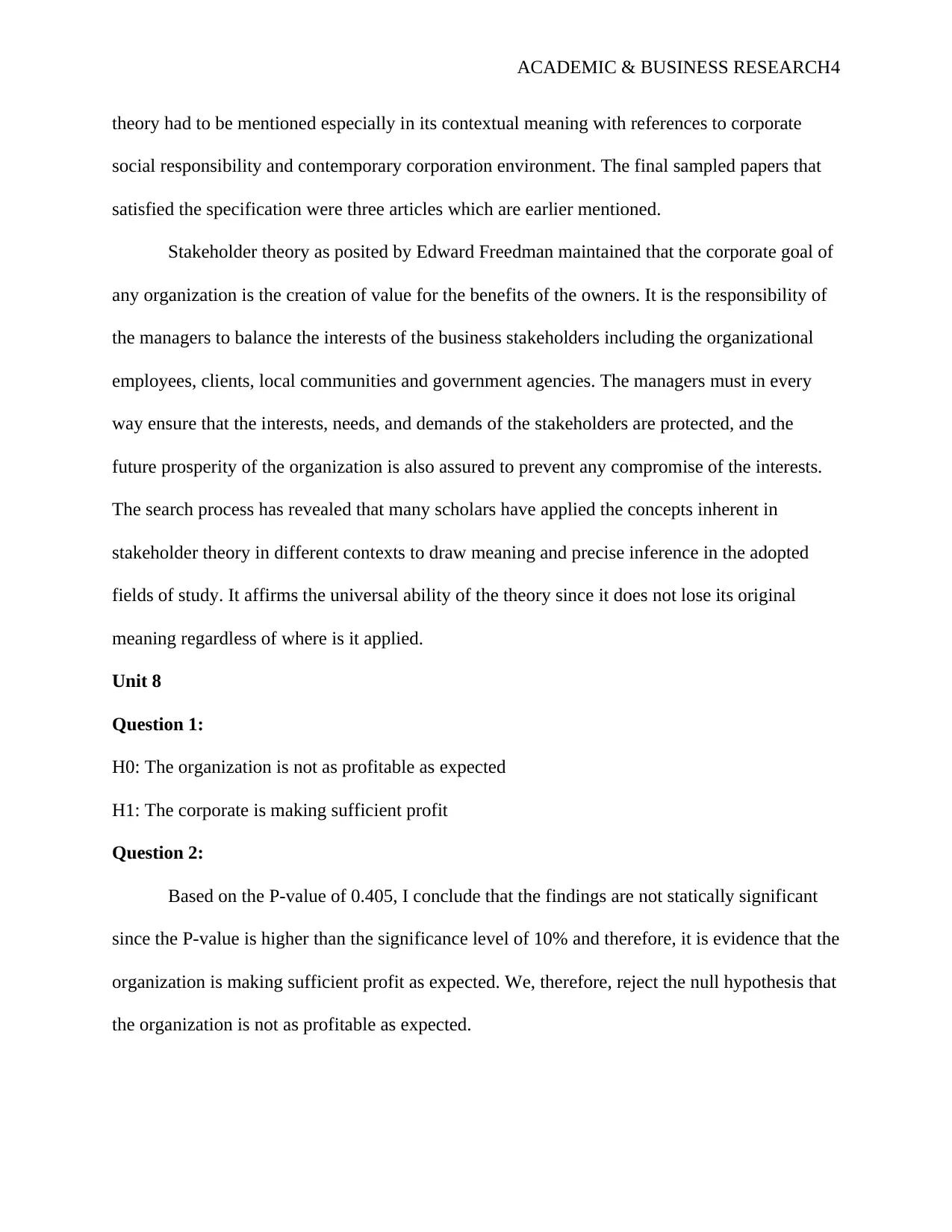
ACADEMIC & BUSINESS RESEARCH4
theory had to be mentioned especially in its contextual meaning with references to corporate
social responsibility and contemporary corporation environment. The final sampled papers that
satisfied the specification were three articles which are earlier mentioned.
Stakeholder theory as posited by Edward Freedman maintained that the corporate goal of
any organization is the creation of value for the benefits of the owners. It is the responsibility of
the managers to balance the interests of the business stakeholders including the organizational
employees, clients, local communities and government agencies. The managers must in every
way ensure that the interests, needs, and demands of the stakeholders are protected, and the
future prosperity of the organization is also assured to prevent any compromise of the interests.
The search process has revealed that many scholars have applied the concepts inherent in
stakeholder theory in different contexts to draw meaning and precise inference in the adopted
fields of study. It affirms the universal ability of the theory since it does not lose its original
meaning regardless of where is it applied.
Unit 8
Question 1:
H0: The organization is not as profitable as expected
H1: The corporate is making sufficient profit
Question 2:
Based on the P-value of 0.405, I conclude that the findings are not statically significant
since the P-value is higher than the significance level of 10% and therefore, it is evidence that the
organization is making sufficient profit as expected. We, therefore, reject the null hypothesis that
the organization is not as profitable as expected.
theory had to be mentioned especially in its contextual meaning with references to corporate
social responsibility and contemporary corporation environment. The final sampled papers that
satisfied the specification were three articles which are earlier mentioned.
Stakeholder theory as posited by Edward Freedman maintained that the corporate goal of
any organization is the creation of value for the benefits of the owners. It is the responsibility of
the managers to balance the interests of the business stakeholders including the organizational
employees, clients, local communities and government agencies. The managers must in every
way ensure that the interests, needs, and demands of the stakeholders are protected, and the
future prosperity of the organization is also assured to prevent any compromise of the interests.
The search process has revealed that many scholars have applied the concepts inherent in
stakeholder theory in different contexts to draw meaning and precise inference in the adopted
fields of study. It affirms the universal ability of the theory since it does not lose its original
meaning regardless of where is it applied.
Unit 8
Question 1:
H0: The organization is not as profitable as expected
H1: The corporate is making sufficient profit
Question 2:
Based on the P-value of 0.405, I conclude that the findings are not statically significant
since the P-value is higher than the significance level of 10% and therefore, it is evidence that the
organization is making sufficient profit as expected. We, therefore, reject the null hypothesis that
the organization is not as profitable as expected.
Paraphrase This Document
Need a fresh take? Get an instant paraphrase of this document with our AI Paraphraser
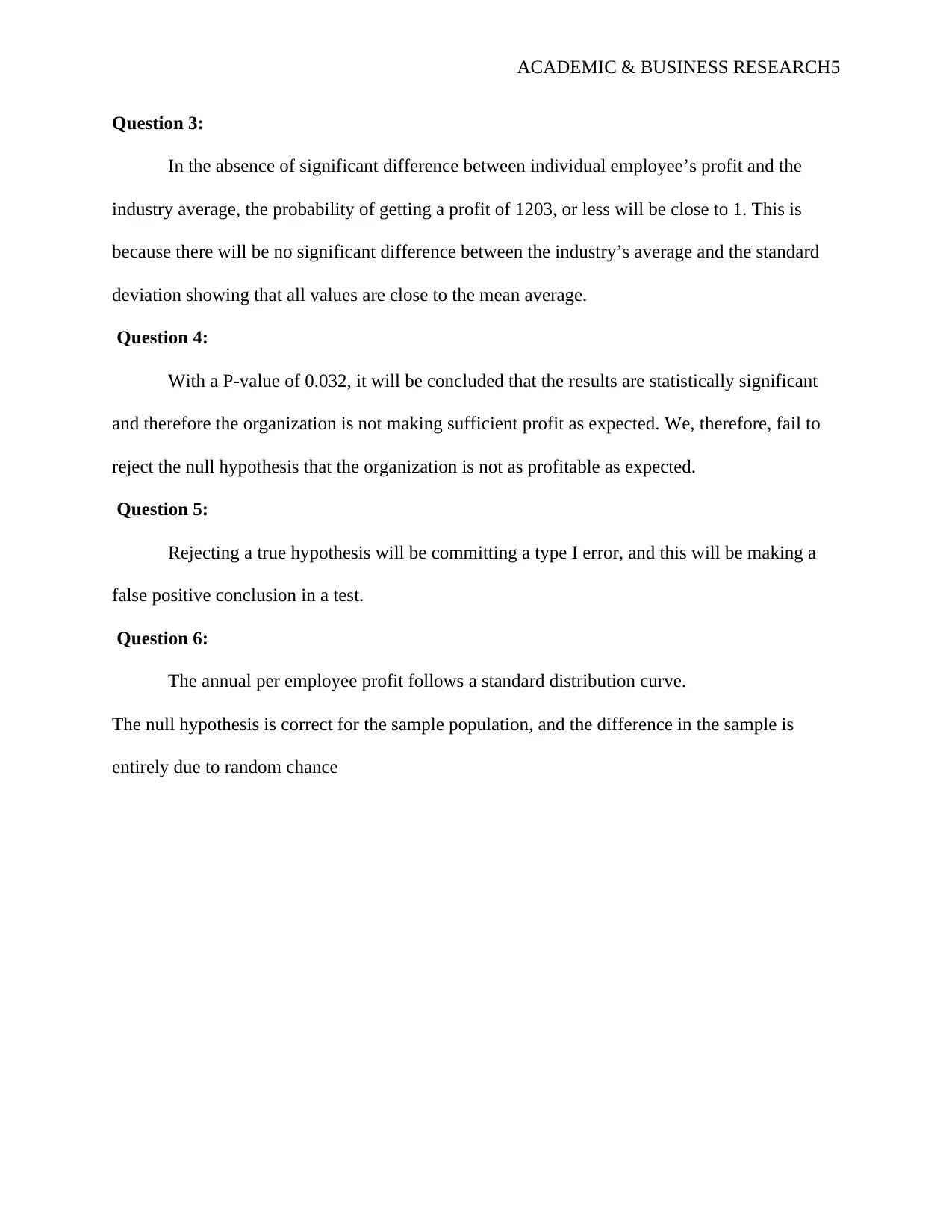
ACADEMIC & BUSINESS RESEARCH5
Question 3:
In the absence of significant difference between individual employee’s profit and the
industry average, the probability of getting a profit of 1203, or less will be close to 1. This is
because there will be no significant difference between the industry’s average and the standard
deviation showing that all values are close to the mean average.
Question 4:
With a P-value of 0.032, it will be concluded that the results are statistically significant
and therefore the organization is not making sufficient profit as expected. We, therefore, fail to
reject the null hypothesis that the organization is not as profitable as expected.
Question 5:
Rejecting a true hypothesis will be committing a type I error, and this will be making a
false positive conclusion in a test.
Question 6:
The annual per employee profit follows a standard distribution curve.
The null hypothesis is correct for the sample population, and the difference in the sample is
entirely due to random chance
Question 3:
In the absence of significant difference between individual employee’s profit and the
industry average, the probability of getting a profit of 1203, or less will be close to 1. This is
because there will be no significant difference between the industry’s average and the standard
deviation showing that all values are close to the mean average.
Question 4:
With a P-value of 0.032, it will be concluded that the results are statistically significant
and therefore the organization is not making sufficient profit as expected. We, therefore, fail to
reject the null hypothesis that the organization is not as profitable as expected.
Question 5:
Rejecting a true hypothesis will be committing a type I error, and this will be making a
false positive conclusion in a test.
Question 6:
The annual per employee profit follows a standard distribution curve.
The null hypothesis is correct for the sample population, and the difference in the sample is
entirely due to random chance
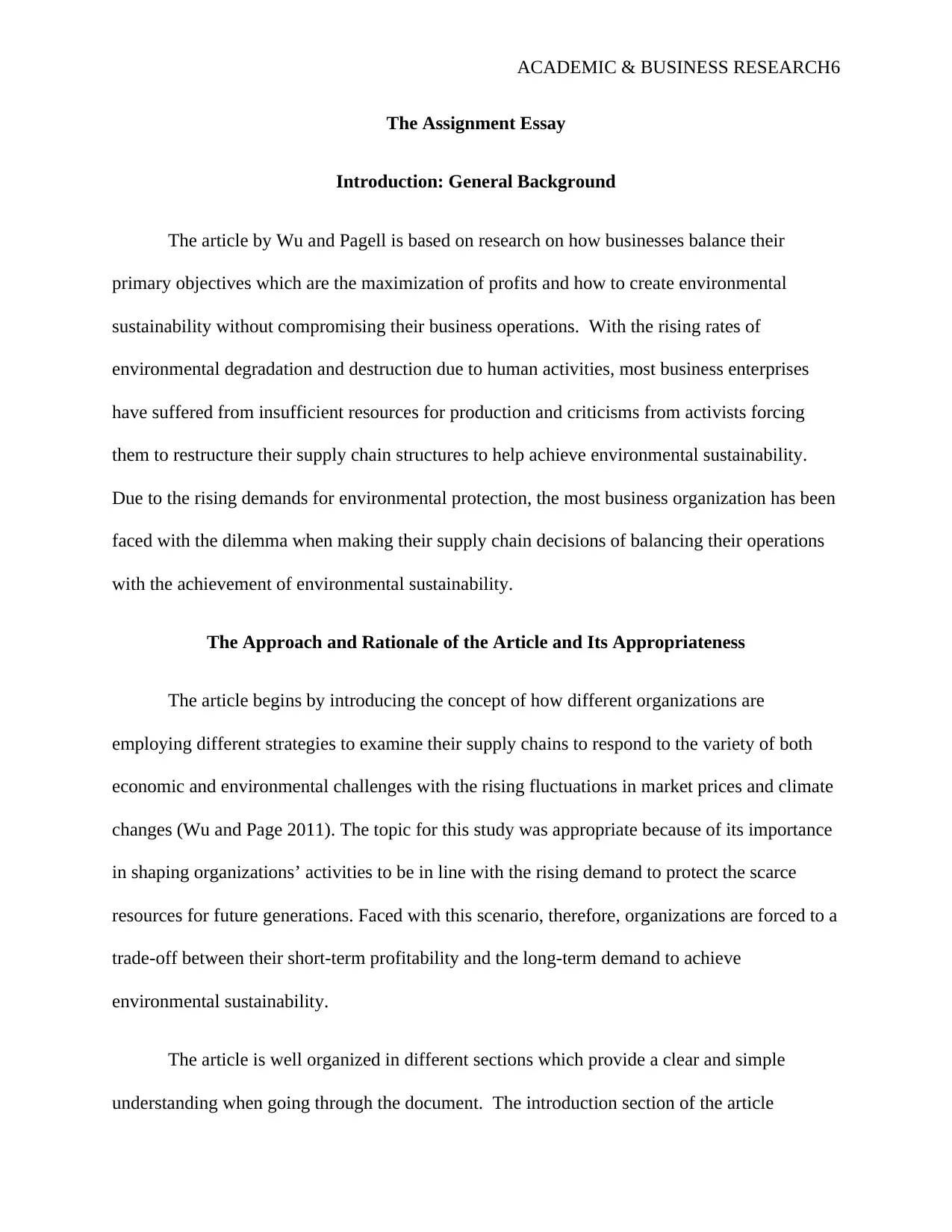
ACADEMIC & BUSINESS RESEARCH6
The Assignment Essay
Introduction: General Background
The article by Wu and Pagell is based on research on how businesses balance their
primary objectives which are the maximization of profits and how to create environmental
sustainability without compromising their business operations. With the rising rates of
environmental degradation and destruction due to human activities, most business enterprises
have suffered from insufficient resources for production and criticisms from activists forcing
them to restructure their supply chain structures to help achieve environmental sustainability.
Due to the rising demands for environmental protection, the most business organization has been
faced with the dilemma when making their supply chain decisions of balancing their operations
with the achievement of environmental sustainability.
The Approach and Rationale of the Article and Its Appropriateness
The article begins by introducing the concept of how different organizations are
employing different strategies to examine their supply chains to respond to the variety of both
economic and environmental challenges with the rising fluctuations in market prices and climate
changes (Wu and Page 2011). The topic for this study was appropriate because of its importance
in shaping organizations’ activities to be in line with the rising demand to protect the scarce
resources for future generations. Faced with this scenario, therefore, organizations are forced to a
trade-off between their short-term profitability and the long-term demand to achieve
environmental sustainability.
The article is well organized in different sections which provide a clear and simple
understanding when going through the document. The introduction section of the article
The Assignment Essay
Introduction: General Background
The article by Wu and Pagell is based on research on how businesses balance their
primary objectives which are the maximization of profits and how to create environmental
sustainability without compromising their business operations. With the rising rates of
environmental degradation and destruction due to human activities, most business enterprises
have suffered from insufficient resources for production and criticisms from activists forcing
them to restructure their supply chain structures to help achieve environmental sustainability.
Due to the rising demands for environmental protection, the most business organization has been
faced with the dilemma when making their supply chain decisions of balancing their operations
with the achievement of environmental sustainability.
The Approach and Rationale of the Article and Its Appropriateness
The article begins by introducing the concept of how different organizations are
employing different strategies to examine their supply chains to respond to the variety of both
economic and environmental challenges with the rising fluctuations in market prices and climate
changes (Wu and Page 2011). The topic for this study was appropriate because of its importance
in shaping organizations’ activities to be in line with the rising demand to protect the scarce
resources for future generations. Faced with this scenario, therefore, organizations are forced to a
trade-off between their short-term profitability and the long-term demand to achieve
environmental sustainability.
The article is well organized in different sections which provide a clear and simple
understanding when going through the document. The introduction section of the article
⊘ This is a preview!⊘
Do you want full access?
Subscribe today to unlock all pages.

Trusted by 1+ million students worldwide
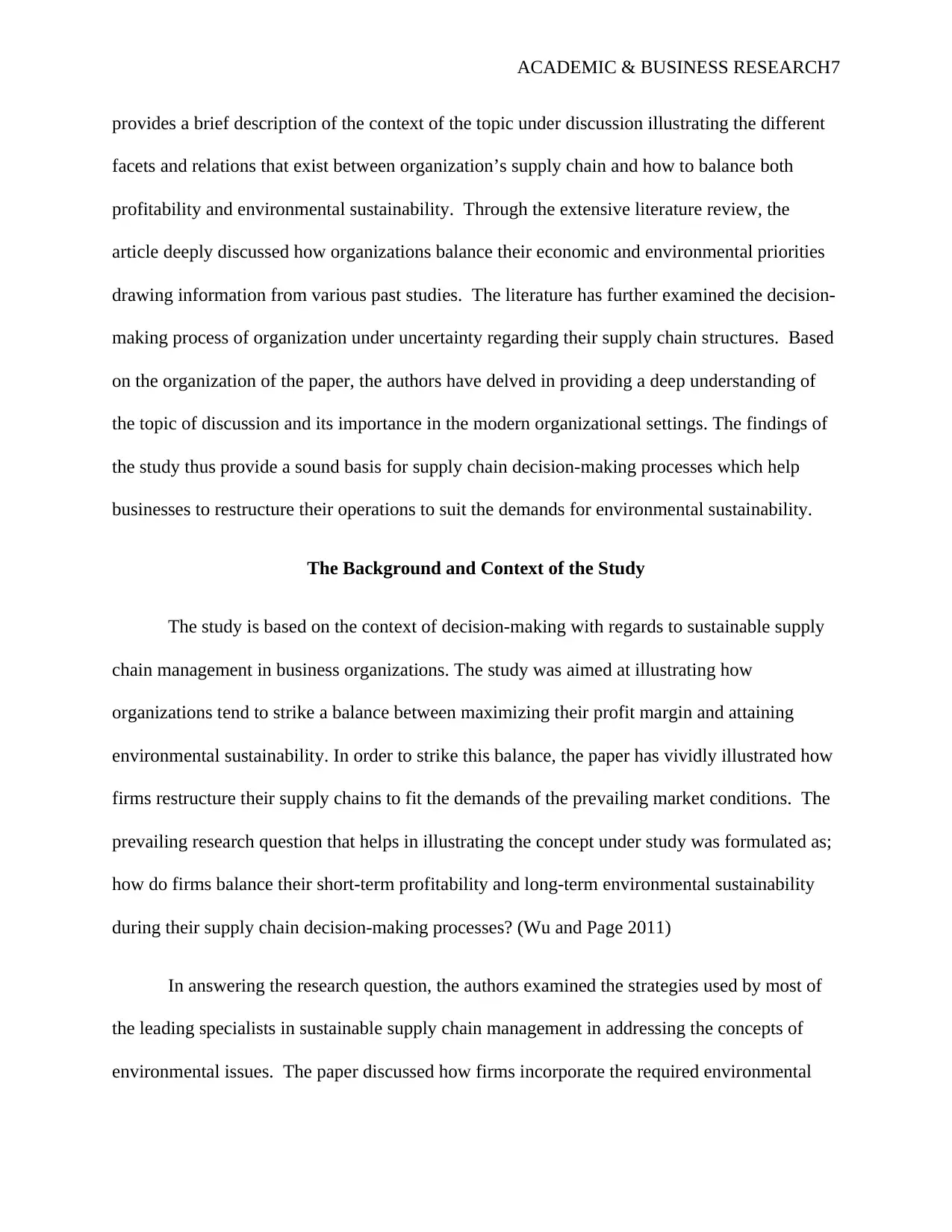
ACADEMIC & BUSINESS RESEARCH7
provides a brief description of the context of the topic under discussion illustrating the different
facets and relations that exist between organization’s supply chain and how to balance both
profitability and environmental sustainability. Through the extensive literature review, the
article deeply discussed how organizations balance their economic and environmental priorities
drawing information from various past studies. The literature has further examined the decision-
making process of organization under uncertainty regarding their supply chain structures. Based
on the organization of the paper, the authors have delved in providing a deep understanding of
the topic of discussion and its importance in the modern organizational settings. The findings of
the study thus provide a sound basis for supply chain decision-making processes which help
businesses to restructure their operations to suit the demands for environmental sustainability.
The Background and Context of the Study
The study is based on the context of decision-making with regards to sustainable supply
chain management in business organizations. The study was aimed at illustrating how
organizations tend to strike a balance between maximizing their profit margin and attaining
environmental sustainability. In order to strike this balance, the paper has vividly illustrated how
firms restructure their supply chains to fit the demands of the prevailing market conditions. The
prevailing research question that helps in illustrating the concept under study was formulated as;
how do firms balance their short-term profitability and long-term environmental sustainability
during their supply chain decision-making processes? (Wu and Page 2011)
In answering the research question, the authors examined the strategies used by most of
the leading specialists in sustainable supply chain management in addressing the concepts of
environmental issues. The paper discussed how firms incorporate the required environmental
provides a brief description of the context of the topic under discussion illustrating the different
facets and relations that exist between organization’s supply chain and how to balance both
profitability and environmental sustainability. Through the extensive literature review, the
article deeply discussed how organizations balance their economic and environmental priorities
drawing information from various past studies. The literature has further examined the decision-
making process of organization under uncertainty regarding their supply chain structures. Based
on the organization of the paper, the authors have delved in providing a deep understanding of
the topic of discussion and its importance in the modern organizational settings. The findings of
the study thus provide a sound basis for supply chain decision-making processes which help
businesses to restructure their operations to suit the demands for environmental sustainability.
The Background and Context of the Study
The study is based on the context of decision-making with regards to sustainable supply
chain management in business organizations. The study was aimed at illustrating how
organizations tend to strike a balance between maximizing their profit margin and attaining
environmental sustainability. In order to strike this balance, the paper has vividly illustrated how
firms restructure their supply chains to fit the demands of the prevailing market conditions. The
prevailing research question that helps in illustrating the concept under study was formulated as;
how do firms balance their short-term profitability and long-term environmental sustainability
during their supply chain decision-making processes? (Wu and Page 2011)
In answering the research question, the authors examined the strategies used by most of
the leading specialists in sustainable supply chain management in addressing the concepts of
environmental issues. The paper discussed how firms incorporate the required environmental
Paraphrase This Document
Need a fresh take? Get an instant paraphrase of this document with our AI Paraphraser
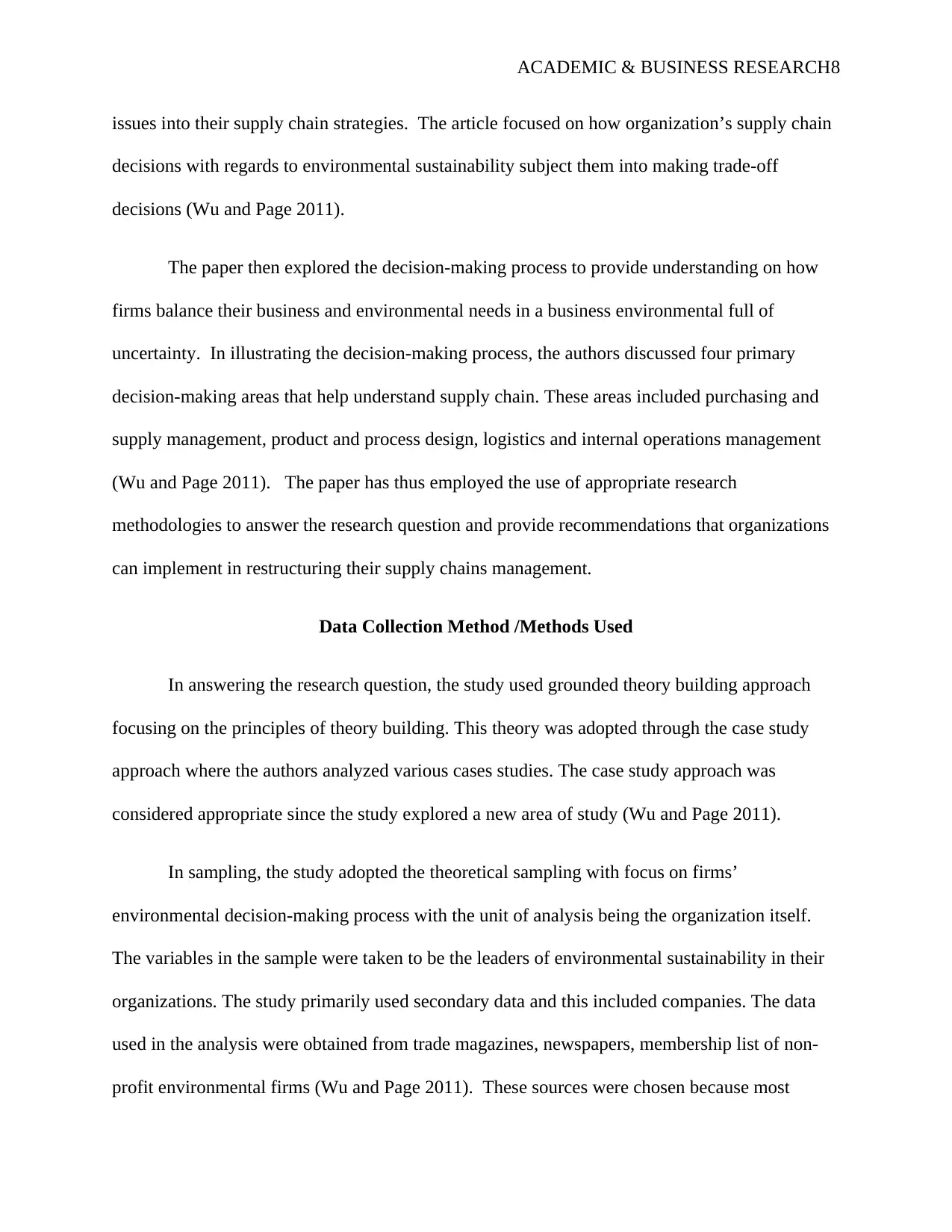
ACADEMIC & BUSINESS RESEARCH8
issues into their supply chain strategies. The article focused on how organization’s supply chain
decisions with regards to environmental sustainability subject them into making trade-off
decisions (Wu and Page 2011).
The paper then explored the decision-making process to provide understanding on how
firms balance their business and environmental needs in a business environmental full of
uncertainty. In illustrating the decision-making process, the authors discussed four primary
decision-making areas that help understand supply chain. These areas included purchasing and
supply management, product and process design, logistics and internal operations management
(Wu and Page 2011). The paper has thus employed the use of appropriate research
methodologies to answer the research question and provide recommendations that organizations
can implement in restructuring their supply chains management.
Data Collection Method /Methods Used
In answering the research question, the study used grounded theory building approach
focusing on the principles of theory building. This theory was adopted through the case study
approach where the authors analyzed various cases studies. The case study approach was
considered appropriate since the study explored a new area of study (Wu and Page 2011).
In sampling, the study adopted the theoretical sampling with focus on firms’
environmental decision-making process with the unit of analysis being the organization itself.
The variables in the sample were taken to be the leaders of environmental sustainability in their
organizations. The study primarily used secondary data and this included companies. The data
used in the analysis were obtained from trade magazines, newspapers, membership list of non-
profit environmental firms (Wu and Page 2011). These sources were chosen because most
issues into their supply chain strategies. The article focused on how organization’s supply chain
decisions with regards to environmental sustainability subject them into making trade-off
decisions (Wu and Page 2011).
The paper then explored the decision-making process to provide understanding on how
firms balance their business and environmental needs in a business environmental full of
uncertainty. In illustrating the decision-making process, the authors discussed four primary
decision-making areas that help understand supply chain. These areas included purchasing and
supply management, product and process design, logistics and internal operations management
(Wu and Page 2011). The paper has thus employed the use of appropriate research
methodologies to answer the research question and provide recommendations that organizations
can implement in restructuring their supply chains management.
Data Collection Method /Methods Used
In answering the research question, the study used grounded theory building approach
focusing on the principles of theory building. This theory was adopted through the case study
approach where the authors analyzed various cases studies. The case study approach was
considered appropriate since the study explored a new area of study (Wu and Page 2011).
In sampling, the study adopted the theoretical sampling with focus on firms’
environmental decision-making process with the unit of analysis being the organization itself.
The variables in the sample were taken to be the leaders of environmental sustainability in their
organizations. The study primarily used secondary data and this included companies. The data
used in the analysis were obtained from trade magazines, newspapers, membership list of non-
profit environmental firms (Wu and Page 2011). These sources were chosen because most
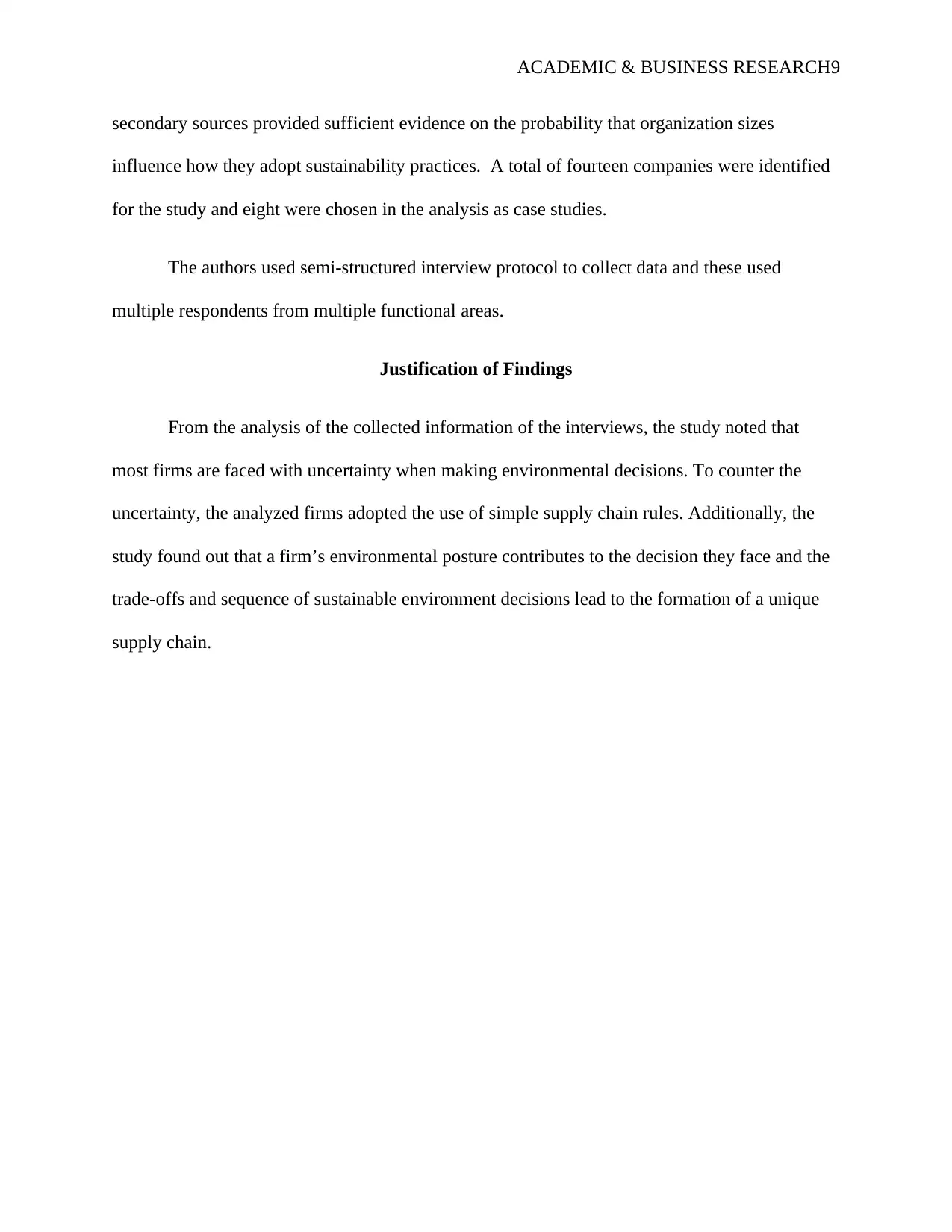
ACADEMIC & BUSINESS RESEARCH9
secondary sources provided sufficient evidence on the probability that organization sizes
influence how they adopt sustainability practices. A total of fourteen companies were identified
for the study and eight were chosen in the analysis as case studies.
The authors used semi-structured interview protocol to collect data and these used
multiple respondents from multiple functional areas.
Justification of Findings
From the analysis of the collected information of the interviews, the study noted that
most firms are faced with uncertainty when making environmental decisions. To counter the
uncertainty, the analyzed firms adopted the use of simple supply chain rules. Additionally, the
study found out that a firm’s environmental posture contributes to the decision they face and the
trade-offs and sequence of sustainable environment decisions lead to the formation of a unique
supply chain.
secondary sources provided sufficient evidence on the probability that organization sizes
influence how they adopt sustainability practices. A total of fourteen companies were identified
for the study and eight were chosen in the analysis as case studies.
The authors used semi-structured interview protocol to collect data and these used
multiple respondents from multiple functional areas.
Justification of Findings
From the analysis of the collected information of the interviews, the study noted that
most firms are faced with uncertainty when making environmental decisions. To counter the
uncertainty, the analyzed firms adopted the use of simple supply chain rules. Additionally, the
study found out that a firm’s environmental posture contributes to the decision they face and the
trade-offs and sequence of sustainable environment decisions lead to the formation of a unique
supply chain.
⊘ This is a preview!⊘
Do you want full access?
Subscribe today to unlock all pages.

Trusted by 1+ million students worldwide
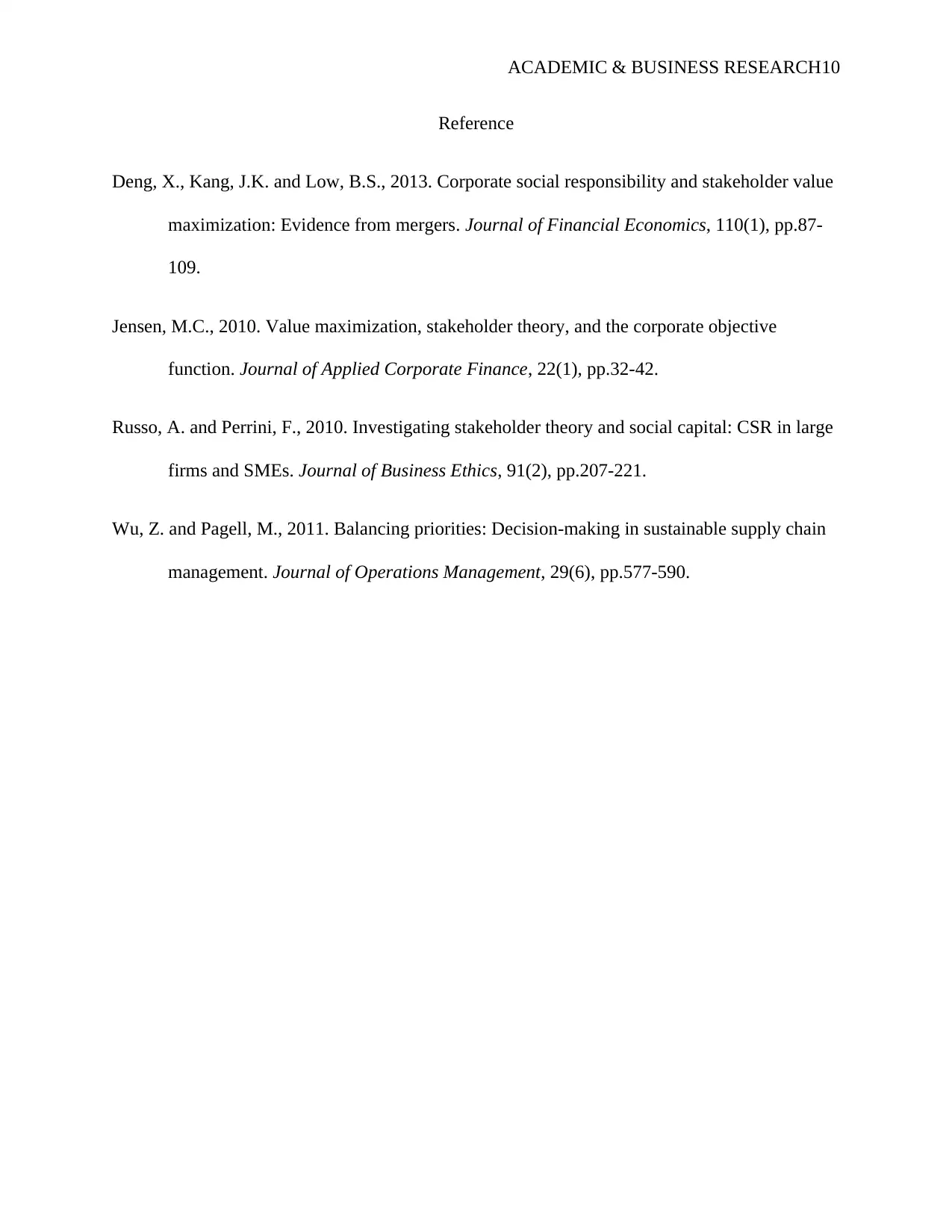
ACADEMIC & BUSINESS RESEARCH10
Reference
Deng, X., Kang, J.K. and Low, B.S., 2013. Corporate social responsibility and stakeholder value
maximization: Evidence from mergers. Journal of Financial Economics, 110(1), pp.87-
109.
Jensen, M.C., 2010. Value maximization, stakeholder theory, and the corporate objective
function. Journal of Applied Corporate Finance, 22(1), pp.32-42.
Russo, A. and Perrini, F., 2010. Investigating stakeholder theory and social capital: CSR in large
firms and SMEs. Journal of Business Ethics, 91(2), pp.207-221.
Wu, Z. and Pagell, M., 2011. Balancing priorities: Decision-making in sustainable supply chain
management. Journal of Operations Management, 29(6), pp.577-590.
Reference
Deng, X., Kang, J.K. and Low, B.S., 2013. Corporate social responsibility and stakeholder value
maximization: Evidence from mergers. Journal of Financial Economics, 110(1), pp.87-
109.
Jensen, M.C., 2010. Value maximization, stakeholder theory, and the corporate objective
function. Journal of Applied Corporate Finance, 22(1), pp.32-42.
Russo, A. and Perrini, F., 2010. Investigating stakeholder theory and social capital: CSR in large
firms and SMEs. Journal of Business Ethics, 91(2), pp.207-221.
Wu, Z. and Pagell, M., 2011. Balancing priorities: Decision-making in sustainable supply chain
management. Journal of Operations Management, 29(6), pp.577-590.
1 out of 10
Your All-in-One AI-Powered Toolkit for Academic Success.
+13062052269
info@desklib.com
Available 24*7 on WhatsApp / Email
![[object Object]](/_next/static/media/star-bottom.7253800d.svg)
Unlock your academic potential
Copyright © 2020–2025 A2Z Services. All Rights Reserved. Developed and managed by ZUCOL.
